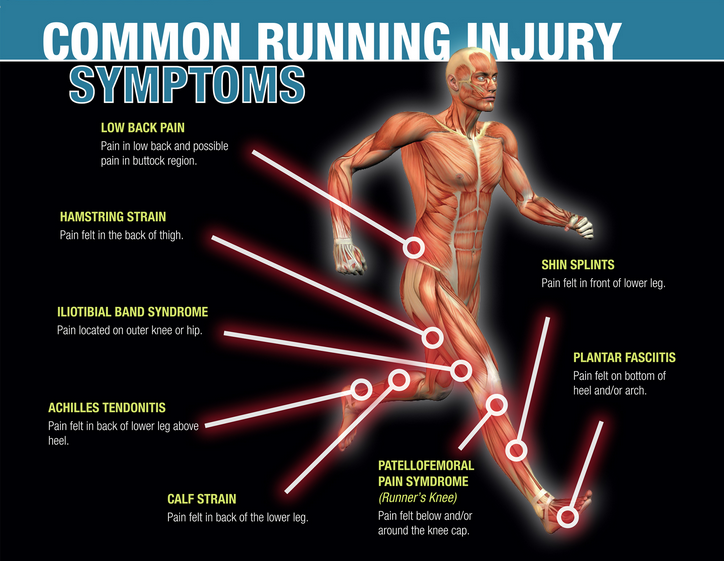Understanding Running Injuries
Navigating the world of long-distance running can be both exhilarating and challenging. One of the challenges that long-distance runners often face is the risk of injuries. The key to overcoming this challenge lies in understanding these injuries and adopting injury prevention exercises.
Injuries among long-distance runners are not uncommon. In fact, studies indicate that a significant number of long-distance runners encounter injuries at some point in their running journey. These injuries typically include stress fractures, shin splints, runner’s knee, and Achilles tendinitis, to name a few.
These injuries occur due to various reasons. Overuse is a common cause, where the repetitive stress on the muscles and joints leads to wear and tear over time. Other causes include improper running form, inadequate rest, and even wearing the wrong type of running shoes.

However, the good news is that these injuries can be prevented through injury prevention exercises for long-distance runners. These exercises are designed to strengthen the muscles and increase flexibility, thus reducing the risk of injury. The importance of injury prevention cannot be overstated. It is not merely about avoiding discomfort or pain; it is about ensuring that runners can continue to enjoy the sport they love in a sustainable manner.
Looking to the future, there is room for further research and development in this area. For instance, creating personalized injury prevention programs that take into account a runner’s specific biomechanics and fitness levels could be a potential game-changer.
In the following sections, we will delve deeper into the realm of injury prevention, exploring various exercises and dietary guidelines that can help long-distance runners stay injury-free. We will also share some inspiring success stories of runners who have successfully incorporated these strategies into their routines.
This journey is not just about running; it’s about taking proactive steps to ensure that running can be a lifelong pursuit. And that starts with understanding and preventing injuries.
The Significance of Injury Prevention
Injury prevention exercises for long-distance runners are not a mere suggestion but a necessity. Their significance stems from their integral role in maintaining consistent running performance, improving a runner’s time, and ensuring longevity in the sport.
Injuries, often a result of overuse or improper technique, can disrupt a runner’s training regimen, thereby affecting their performance. A consistent runner is a successful one, and nothing hinders consistency more than recurring injuries. Therefore, injury prevention exercises are essential in preserving a runner’s rhythm and momentum.

Moreover, these exercises can improve a runner’s time. A healthy runner is an efficient one. By strengthening the muscles and increasing flexibility, preventive exercises can enhance a runner’s stride, leading to improved speed and endurance.
The role of injury prevention in ensuring longevity in the sport is also significant. Long-distance running is not a sprint; it’s a marathon. The goal is not just to run fast but to keep running for as long as possible. Injury prevention exercises strengthen a runner’s resilience, ensuring they can continue to participate in the sport they love for many years.
Looking at the future, the importance of injury prevention will only increase as more people embrace long-distance running. Innovative approaches to injury prevention, such as wearable technology that can monitor a runner’s form and provide real-time feedback, could take injury prevention to the next level.
In the end, it’s not just about preventing injuries; it’s about creating a sustainable running lifestyle. Injury prevention exercises for long-distance runners are the building blocks of such a lifestyle. They enable runners to keep doing what they love most – running – consistently, efficiently, and for a long time.
How to Combat Injuries: A Guide to Injury Prevention Exercises
Injury prevention exercises for long-distance runners are a crucial part of any training regimen. These exercises aim to strengthen the body’s key areas that are most susceptible to running-related injuries. Let’s delve into some of these exercises, categorized based on the part of the body they target.

**Lower Body Exercises**
The lower body, comprising the legs and the core, bears the brunt of the impact during running. Strengthening these areas can significantly reduce the risk of injuries such as shin splints and runner’s knee. Some effective lower body exercises include calf raises, lunges, and squats.
**Upper Body Exercises**
While running is primarily a lower body activity, the upper body’s strength and stability can influence running efficiency. Exercises like push-ups, pull-ups, and shoulder presses can help build upper body strength.
**Core Exercises**
A strong core can improve running posture and reduce the strain on the lower body. Planks, Russian twists, and bird dogs are excellent exercises for strengthening the core.
Each exercise comes with its own set of benefits and precautions. For instance, while squats can strengthen the quadriceps and hamstrings, they should be performed with proper form to avoid putting undue stress on the knees.
In the future, we could see the integration of technology in designing and performing these exercises. Virtual reality, for instance, could provide a more immersive and interactive exercise experience, making injury prevention exercises more engaging and effective.
Remember, the goal is not just to perform these exercises, but to make them a regular part of your training routine. Consistency is key in reaping the benefits of these exercises and making your running journey a smooth and enjoyable one.
Fueling Your Run: Nutrition’s Role in Injury Prevention
Proper nutrition plays a pivotal role in injury prevention for long-distance runners. The right nutrients not only aid in muscle recovery but also strengthen the body’s resistance to injury.

**Muscle Recovery**
Nutrients such as protein, omega-3 fatty acids, and antioxidants are essential for muscle recovery. Protein helps repair and rebuild muscle tissues, while omega-3 fatty acids and antioxidants reduce inflammation and oxidative stress, promoting faster recovery.
**Strengthening Resistance to Injury**
Certain nutrients, including vitamin C, vitamin D, and calcium, contribute to strengthening the body’s overall resistance to injury. Vitamin C aids in collagen synthesis, which is crucial for tendon and ligament health, while vitamin D and calcium support bone strength and density.
**Hydration and Electrolyte Balance**
Maintaining proper hydration and electrolyte balance is vital for preventing cramps and muscle fatigue during long-distance runs. Electrolytes like sodium, potassium, and magnesium play a key role in muscle function and hydration.
In the future, advancements in personalized nutrition tailored to individual runners’ needs could revolutionize injury prevention. Utilizing data from genetic testing and performance metrics, personalized nutrition plans could optimize runners’ resilience to injuries and enhance their overall performance.
By understanding the critical role of nutrition in injury prevention, long-distance runners can not only improve their performance but also ensure their long-term health and well-being.
The Long Game: Consistency in Prevention Exercises
Consistency is the cornerstone of effective injury prevention for long-distance runners. It’s not just about performing prevention exercises; it’s about making them an integral part of your daily routine.

**Incorporating Prevention Exercises**
Consistency begins with incorporating prevention exercises into your daily routine. Whether it’s a morning stretch, a midday strength session, or an evening cooldown, integrating these exercises into your daily schedule is crucial for long-term success.
**Balancing Rest and Activity**
Consistency also involves finding the right balance between rest and activity. Overtraining can lead to fatigue and increased injury risk, while inadequate activity can result in reduced resilience. Finding the sweet spot between rest and activity is essential for maintaining consistency in injury prevention.
**Mindful Nutrition**
Consistency extends beyond exercises to include proper nutrition. Ensuring that your body receives the necessary nutrients for muscle recovery and overall health is vital. Consistently fueling your body with the right nutrients can significantly enhance the effectiveness of injury prevention exercises.
In the future, advancements in wearable technology and personalized training plans could further enhance the consistency of injury prevention. Wearable devices that provide real-time feedback on form and technique, coupled with personalized training plans tailored to individual needs, could revolutionize the way runners approach injury prevention.
By emphasizing the importance of consistency in injury prevention exercises and maintaining proper nutrition, long-distance runners can ensure a sustainable and injury-free running journey for years to come.
Case Study: Real Runners, Real Results
Injury prevention exercises for long-distance runners have proven to be highly effective in improving performance and health. This is best illustrated through real-life examples of runners who have seen significant improvements in their performance and overall health.

**Case Study 1: The Olympic Gold Medalist**
Consider the case of an anonymous Olympic gold medalist. After incorporating injury prevention exercises into their training routine, they saw a marked improvement in their performance, ultimately winning a gold medal at the Olympics [[4]]. This achievement was not only a personal success but also a testament to the effectiveness of consistent injury prevention exercises.
**Case Study 2: The Nervous Eater**
Another example is a runner who had a habit of eating too much sugar when nervous [[2]]. After integrating injury prevention exercises into their routine, they were able to better manage their nerves, improve their diet, and enhance their running performance.
These case studies underscore the importance of injury prevention exercises for long-distance runners. However, it’s important to note that every runner is unique, and what works for one may not work for another. Therefore, future improvements could include personalized injury prevention plans tailored to each runner’s specific needs and circumstances.
By sharing these real-life examples, it’s clear that injury prevention exercises can lead to significant improvements in performance and health for long-distance runners. It’s not just about preventing injuries; it’s about enhancing overall well-being and achieving personal bests in the sport.

